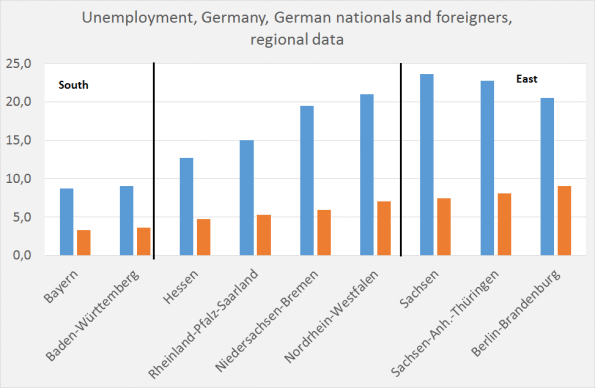From: Merijn Knibbe The graph shows the ‘Ausländerarbeitslosenquote’ (unemployed foreigners ratio) which is calculated by the ‘Bundesagentur fur Arbeit’ (a kind of German ‘Bureau of Labor Statistics’). Unemployment of Germans in East Germany is, after about a quarter of a century, finally below 10% (but still high). But unemployment among ‘foreigners’ is way higher (foreigners are not necessarily immigrants: refugees and people from the Not Very United Kingdom count but so does the large share of the sizeable second or third generation Turkish minority which does not have German nationality). Fun fact: unemployment of foreigners in Bayern is lower than unemployment of German nationals in Berlin Brandenburg (September 2016). but it is still way above the German level. Which indicates that dual employment policies are needed: macro and micro (but micro policies are really hard). Political incorrectness of the day: Erdogan calls upon German Turks to do better, economically. As German Turks do relatively bad, even for ‘Ausländer’, this is not just understandable but even positive. What I didn’t know: according to Wikipedia a considerable number of the about four million Turks in Germany descend from the post 1918 Turkish diaspora in countries like Bulgaria, Greece, Cyprus and Lebanon.
Topics:
Merijn T. Knibbe considers the following as important: Uncategorized
This could be interesting, too:
tom writes The Ukraine war and Europe’s deepening march of folly
Stavros Mavroudeas writes CfP of Marxist Macroeconomic Modelling workgroup – 18th WAPE Forum, Istanbul August 6-8, 2025
Lars Pålsson Syll writes The pretence-of-knowledge syndrome
Dean Baker writes Crypto and Donald Trump’s strategic baseball card reserve
from: Merijn Knibbe
The graph shows the ‘Ausländerarbeitslosenquote’ (unemployed foreigners ratio) which is calculated by the ‘Bundesagentur fur Arbeit’ (a kind of German ‘Bureau of Labor Statistics’). Unemployment of Germans in East Germany is, after about a quarter of a century, finally below 10% (but still high). But unemployment among ‘foreigners’ is way higher (foreigners are not necessarily immigrants: refugees and people from the Not Very United Kingdom count but so does the large share of the sizeable second or third generation Turkish minority which does not have German nationality). Fun fact: unemployment of foreigners in Bayern is lower than unemployment of German nationals in Berlin Brandenburg (September 2016).
but it is still way above the German level. Which indicates that dual employment policies are needed: macro and micro (but micro policies are really hard). Political incorrectness of the day: Erdogan calls upon German Turks to do better, economically. As German Turks do relatively bad, even for ‘Ausländer’, this is not just understandable but even positive.
What I didn’t know: according to Wikipedia a considerable number of the about four million Turks in Germany descend from the post 1918 Turkish diaspora in countries like Bulgaria, Greece, Cyprus and Lebanon. Also: the unemployment metric used here is slightly less restrictive than the U-3 metric used by Eurostat (see Edward Fullbrook for a critical look at this metric, look here for my view, both published in the Real World Economics Review), the site of the Bundesagentur has by the way ample data on ‘broad unemployment’. The point: the unemployment data serve to show regional and social differences but should not be understood as the absolute level of either labor slack/lack of opportunities.
